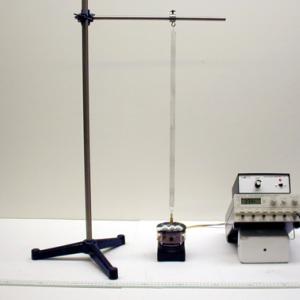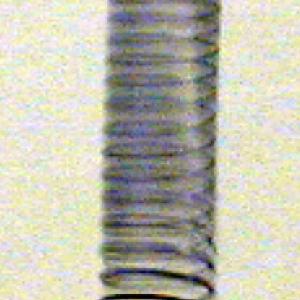College of Liberal Arts & Sciences
3B22.51 - Standing Pulses in a Spring
Attach the spring to the mechanical oscillator and stretch to between 30 and 60 cm. Turn the wave generator from 10 to 70 Hz. As you sweep that set of frequencies you should observe the number of standing pulses in the spring go from 2 to about 7.
When using the camera to image the spring you will need to put a white screen behind the spring.
- Theodore Foster, Willem van Wyngaarden, Arthur Cary, and John Mottmann, "On the g/2 Acceleration of a Pulse in a Vertical Chain", TPT, Vol. 51, #7, Oct. 2013, p. 394.
- Casey Rutherford, "A Fresh Look at Longitudinal Standing Waves on a Spring", TPT, Vol. 51, #1, Jan. 2013, p. 22.
- P. J. Ouseph and Thomas Poothackanal, "Longitudinal and Transverse Waves in a Spring", TPT, Vol. 32, #5, May 1994, p. 285.
- P. J. Ouseph, "Standing Longitudinal Waves", AJP, Vol. 55, #7, July 1987, p. 666.
- A. D. Bulman, "A Standing-Wave Apparatus", Model-Making for Physics, p. 53.
- Robert Ehrlich, "J.9. Longitudinal Waves Around a Circle", Turning the World Inside Out and 174 Other Simple Physics Demonstrations, p. 135.
Disclaimer: These demonstrations are provided only for illustrative use by persons affiliated with The University of Iowa and only under the direction of a trained instructor or physicist. The University of Iowa is not responsible for demonstrations performed by those using their own equipment or who choose to use this reference material for their own purpose. The demonstrations included here are within the public domain and can be found in materials contained in libraries, bookstores, and through electronic sources. Performing all or any portion of any of these demonstrations, with or without revisions not depicted here entails inherent risks. These risks include, without limitation, bodily injury (and possibly death), including risks to health that may be temporary or permanent and that may exacerbate a pre-existing medical condition; and property loss or damage. Anyone performing any part of these demonstrations, even with revisions, knowingly and voluntarily assumes all risks associated with them.

